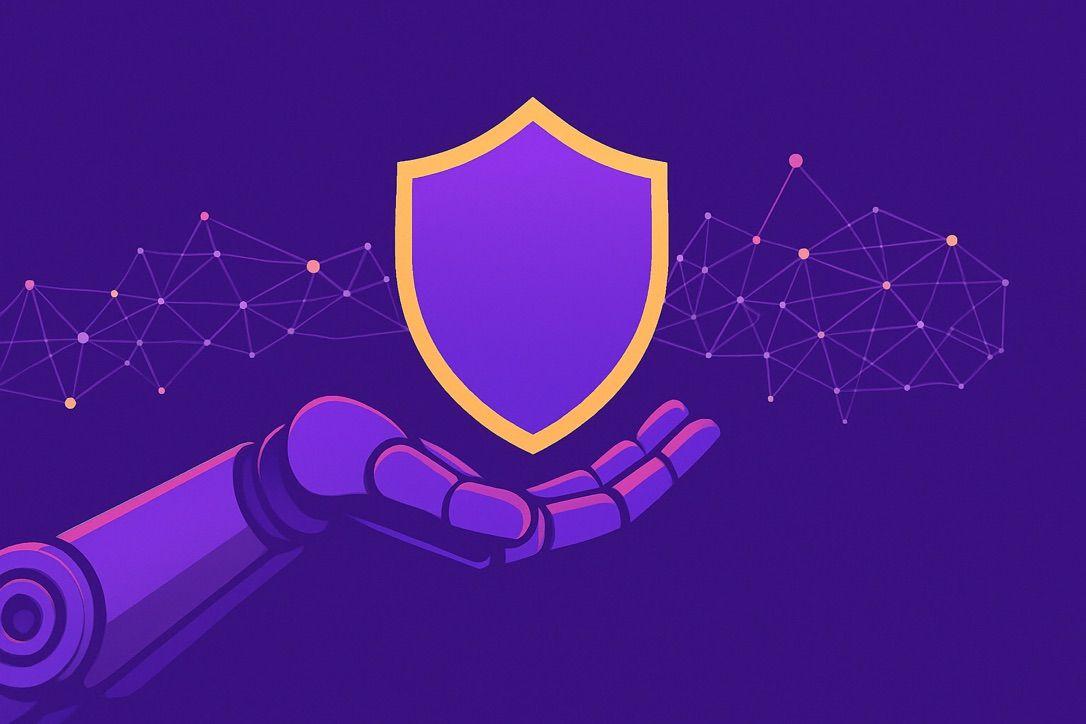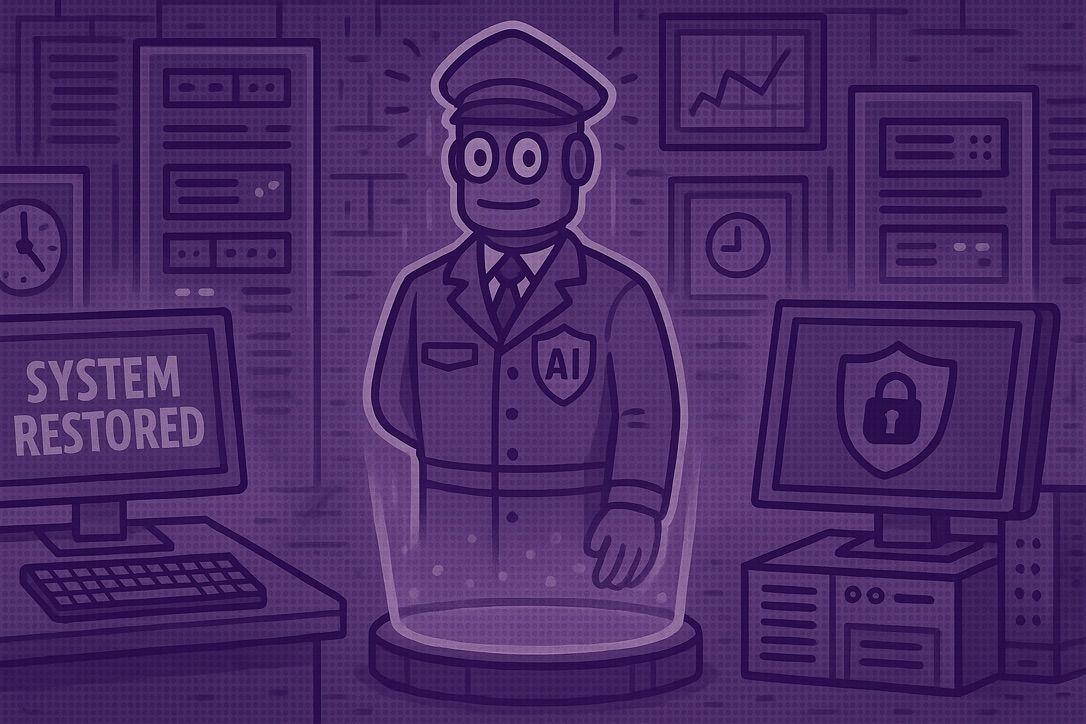- CYBERSECURITY
- AI
- PRIVACY
The AI Shield: How Artificial Intelligence is Changing Cybersecurity
Jul 15, 2025
-
Emilia Skonieczna
-
9 minutes

The tech industry grows incredibly fast, which means that cyber threats are evolving faster than ever. This means that traditional cybersecurity strategies are becoming increasingly ineffective. Now, hackers leverage advanced attack techniques, from AI generated phishing scams to automated malware, making traditional defenses increasingly outdated. This creates an urgent need for smarter and more adaptive security solutions, both for consumers and organizations.
But how exactly does AI revolutionize cybersecurity, and what challenges come with it? Let's see how AI is reshaping digital defense strategies and why it's becoming necessity in the fight against cybercrime.
In recent years, the digital age has brought a significant increase in cyber threats. From ransomware attacks to advanced phishing schemes, hackers are constantly evolving their methods to take advantage of weaknesses in business IT infrastructure. The widespread adoption of cloud computing, the rise of Internet of things (IoT) devices, and remote work have expanded the attack surface, making organizations more prone to a range of cyber risks.
For years, companies have relied on firewalls, antivirus software and basic encryption to protect their system. Although these techniques used to be reliable solutions, they are now insufficient to meet today's changing threats. Cybercriminals have grown smarter, faster and more unpredictable. Modern attacks use AI, take advantage of human error and change in real time, making it difficult for traditional systems to stay up to date.
As organizations face more advanced threats, relying on outdated security measures is like locking your front door while leaving the windows wide open. Today's threats require proactive, AI-driven cybersecurity solutions that detect anomalies instantly, respond autonomously and continuously learn from new attack techniques. The key is no longer just defense, it's anticipation.
AI cybersecurity is changing the way organizations protect sensitive data and critical systems. The role of artificial intelligence in cybersecurity is growing, providing advanced tools to detect, prevent and respond to cyberattacks faster and more accurate than ever.
By leveraging AI and ML, security teams can analyze large amounts of data, detect hidden threats and stop attacks before they even start. AI can automate threat detection and response, minimizing human error and significantly improving defense mechanisms. AI for cybersecurity enables real time monitoring, anomaly detection and predictive analysis, strengthening overall security.
Organizations that use AI to strengthen their cybersecurity gain a competitive advantage by minimizing risks and building stronger defenses. AI is reshaping cybersecurity, leading to a safer and more secure digital world.
One of the biggest benefits of AI in cybersecurity is its ability to detect threats in real time through an advanced anomaly detection system. If something unusual happens, such as unauthorized access attempts, the AI can detect it immediately and block it. This means that problems are stopped before they even start, keeping your data safe.
Imagine having a security system that doesn't just watch, but predicts danger. That's what AI does. It's like a fast detective, who constantly looks for weird patterns that could mean a cyberattack or security breach.
AI-powered automated incident response significantly reduces mean time to resolution (MTTR). By immediately identifying and containing threats, organizations minimize operational downtime and potential financial losses. So. basically, AI is a powerful cybersecurity tool.
Imagine your house has a super smart alarm system. If someone tries to break in, it doesn't just make noise, it calls the police and locks all the doors. That's what automated incident response is like. AI can automatically take action when it sees a cyberattack.
Leveraging behavioral analysis, AI establishes a baseline of normal network activity. Variations from this baseline trigger alerts, enabling proactive threat mitigation. This approach enhances security by detecting advanced attacks that bypass traditional signature-based systems, providing a layer of adaptive defense against evolving cyber threats.
Think of it like a teacher who knows everyone's normal behavior. If someone starts acting weird, the teacher knows something's up. AI does the same thing online. If something unusual happens, it alerts the security analyst.
Have you ever got an email that looks like it's from your favorite game, but it's actually trying to trick you? AI can help spot those fake activities. AI algorithms analyze email content, URLs and sender behavior to identify and block phishing attempts with high accuracy. Machine Learning models continuously adapt to new fraud patterns, significantly reducing the risk of data breaches and financial fraud. This shows how much is the impact of AI on cybersecurity.
Adaptive security measures use AI techniques to analyze constantly changing security data, which allows systems to adapt dynamically, like a video game where enemies grow stronger as the player progresses. Similarly, AI continuously learns about new risks and adjusts security protocols to stay one step ahead.
By monitoring and adapting in real time, AI ensures that security systems remain effective against evolving attack techniques. This proactive approach enhances overall security posture and reduces the risk of successful cyberattacks.

There are numerous AI solutions available to support cybersecurity processes. Nowadays, it’s required to implement AI into your systems. However, it's important to ensure that AI is properly implemented to achieve the best results. Let’s take a look at some of the solutions available in the market.
Think of your network as a house with multiple entry points. An Intrusion Detection System is like a security camera monitoring them. When AI uses Machine Learning, it doesn't just watch, it learns what's normal and detects anomalies. If someone tries to break in, AI sounds the alarm. An Intrusion Prevention System goes further. It not only detects threats but also blocks them, securing your digital doors and windows. ML and AI make your defenses smarter, faster and more proactive.
Your phone, laptop, tablet, these are your endpoints. They're like little outposts in your digital world. AI-driven Endpoint Security is like having a personal bodyguard for each of them. It watches for anything unusual, like viruses or dangerous apps trying to get in. It learns what's normal for your devices and stops anything that's not, keeping your personal information safe.
Cyber Threat Intelligence is like a network of detectives sharing critical information about threats. AI helps by analyzing large amounts of data at incredible speed, identifying patterns and connections that human analyst might miss. AI security enables organizations to predict and mitigate potential cyberattacks before they happen. It's like having a strategic advantage, revealing hidden risks and strengthening defenses.
The cloud is a large, shared digital space where we store data and applications. In such a dynamic environment, security is essential, and that's where AI steps in. In Cloud Security, artificial intelligence acts like a vigilant guardian that never sleeps. It continuously monitors activity, detects threats and ensures your data stays protected.
With advanced analytics and real time threat detection, AI provides a resilient line of defense against unauthorized access and malicious activity. It's not just technology, it's the backbone of security for modern organizations.
While AI offers huge potential in cybersecurity, several challenges need to be addressed. One key issue is the constantly evolving nature of cyber threats. Additionally, AI systems require large amounts of high quality data to function effectively, and obtaining this data can sometimes be difficult due to privacy concerns. Another challenge is adversarial AI, where attackers use AI to bypass security measures. Lastly, AI is not perfect and still requires human oversight.
Cybercriminals are not just targets, they also use AI to enhance their attacks. Generative AI in cybersecurity enables attackers to create realistic fake threats or advanced malware designed to bypass defenses. In this battle of intelligence, AI networks need to detect and respond faster than malicious systems.
For AI to identify potential threats effectively, it requires access to large datasets, sometimes including sensitive personal information. Balancing effective security with privacy is key to ensure ethical practices. Transparency and responsible data handling are necessary as we integrate AI and cybersecurity systems.
While AI can help automate threat detection and response, it is not infallible. Over-reliance on automation can lead to blind spots. Human oversight remains critical to interpret context and make judgements calls where AI falls short. A balanced approach where technology and human expertise work together ensures more reliable protection.
Addressing these challenges is key to harnessing the full potential of AI securing digital environments.

As cyber threats become increasingly advanced, the power of AI is revolutionizing the way organizations protect their digital assets. AI security solutions are helping businesses automate routine tasks, allowing security teams to focus on more complex issues. The impact of artificial intelligence in cybersecurity is huge, enabling faster threat detection and more accurate responses.
As AI continues to evolve, it will empower security systems to adapt and respond with greater precision, offering enhanced protection against emerging threats. With AI’s ability to analyze large amounts of data quickly, businesses are able to stay ahead of cybercriminals and strengthen their security frameworks like never before.
Here's how AI can enhance your cybersecurity efforts:
Automates routine tasks: Security teams can save a lot of time by using AI to automate repetitive security operations. AI helps organizations simplify tasks like monitoring and log analysis, allowing security professionals to focus on more complex problems.
Enhances threat detection: AI quickly identifies security vulnerabilities and attacks, reducing response time. It analyzes patterns and detects unusual activities that might be difficult for people to spot.
Improves decision-making: AI-based cybersecurity solutions helps organizations automate the processes of analyzing large amounts of data to provide valuable security insights, helping teams make better decisions and respond faster to threats. By identifying trends, detecting risks, and recommending actions, AI tools enable security teams to make more strategic choices based on real time data.
Improves adaptability: As cyber threats evolve, AI systems adapt to keep your organization ahead of emerging risks. AI learns from new attack techniques and continuously updates its defenses, improving protection against cyber threats.

AI and Cybersecurity: How artificial intelligence is reshaping digital security measures against sophisticated threats.

Did you know you can reduce business downtime with AI? See how tools from smart monitoring to predictive maintenance keep your business online.

From innovation to intrusion? AI’s use of data scraping is raising more than a few red flags for privacy and consent - find out where the line is being crossed.